-
What is a nucleon?A constituent of the nucleus : a protons or a neutron
-
State a use of radioactive isotopesCarbon dating - the proportion of carbon - 14 in a material can be used to estimate its age
-
What is the strong nuclear force?The fundamental force that keeps the nucleus stable by counteracting the electrostatic force of repulsion between protons
-
Describe the range of the strong force?Repulsive ~ 0.5fm Attractive ~0.5-3fm (greatest ~1fm) Zero past 3fm
-
What makes a nucleus unstable?Nuclei which have too many of either protons or neutrons or both
-
How do nuclei with too many neutrons decay?Beta minus decay in which a neutron decays to a proton by the weak interaction (quark character has changed)
-
How was the existance of the neutrino hypothesised?The energy of particles after beta decay was lower than before, a particle with 0 charge (to conserve change) and negligible mass must carry away this excess energy, this particle is the neutrino
-
What is meant by beta minus decay?When a neutrn turns into a proton, the atom releases an electron and an anti-electron neutrino
-
What occurs when a particle and antiparticle meet?Annihilation The mass of the particle and antiparticle is converted back to energy in the form of 2 gamma ray photons which go in opposite directions to conserve momentum
-
What is pair production?A gamma ray photon is converted into a particle-antiparticle pair.
-
Name the 4 fundamental forces.Gravity Electromagnetic Weak nuclear Strong nuclear
-
What type of particles are affected by the strong nuclear force?Hadrons
-
What is the exchange particle of the weak nuclear force?The W boson
-
When does weak nuclear interaction occur?When quark character changes, it affects all types of particles.
-
Which properties must be conserved in particle interactions?Energy Charge Baryon number Lepton number Momentum Strangeness ONLY FOR STRONG INTERACTIONS
-
What is a hadron?Baryons and mesons (made of two or more quarks held together by the strong nuclear force)
-
What are the classes of hadrons?Baryons, mesons
-
The pion can be an exchange particle for which force?the strong nuclear force
-
What are some example of leptons?Electron Muon Neutrino Tau The antiparticles of the above
-
What does a muon decay into?
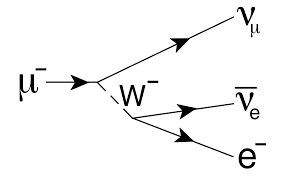
-
Is strangeness always conserved in weak interaction?No, strangeness is ony conserved in the strong interaction it can change by +-1 or not in weak interaction
-
How are strange particles prodced and how do they decay?Produced through strong interaction Decay through the weak interaction
-
Lepton interaction typesAll leptons participate in the weak interaction (by emitting or absorbing a W boson), including charged leptons decaying into lighter leptons Only charged leptons participate in electromagnetic interaction by emitting or absorbing a virtual photon No lepton participate in the strong interaction
-
Feynman diagram for repulsion of electrons
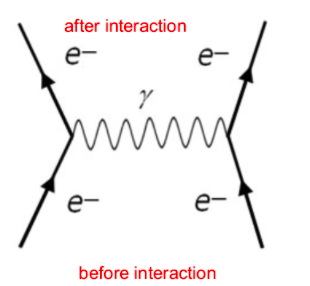 Electromagnetic interaction Two electrons approach each other and they are repelled then they change direction as a virtual photon passes between them.
Electromagnetic interaction Two electrons approach each other and they are repelled then they change direction as a virtual photon passes between them. -
Feynman diagram for proton repulsion
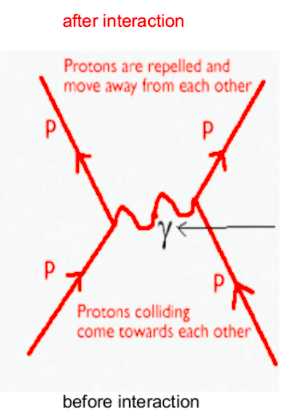 Electro magnetic repulsion Two protons approach each other and they are repelled, they then change direction as a virtual photon passes between them.
Electro magnetic repulsion Two protons approach each other and they are repelled, they then change direction as a virtual photon passes between them. -
Beta minus and beta plus decay equations
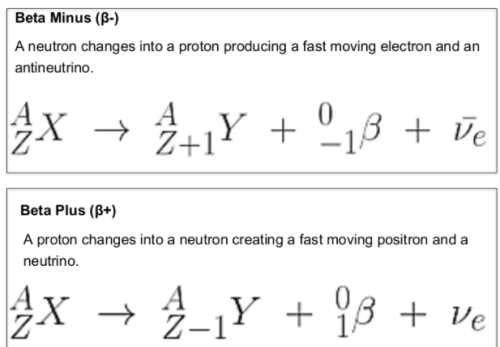
-
Feynman diagram for proton and anti neutrino interaction
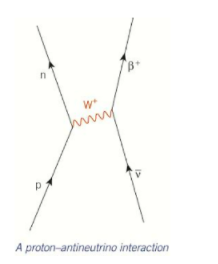 An antineutrino can interact with a proton and make it change into a proton. A beta minus particle (an electron) is created and emitted as a result of the change. W+ from p to v
An antineutrino can interact with a proton and make it change into a proton. A beta minus particle (an electron) is created and emitted as a result of the change. W+ from p to v -
Feynman diagram for neutron and neutrino interaction
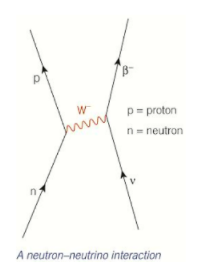 A neutrino can interact with a neutron and make it change into a proton. A beta minus particle (an electron) is created and emitted as a result of the change. W- n to v
A neutrino can interact with a neutron and make it change into a proton. A beta minus particle (an electron) is created and emitted as a result of the change. W- n to v -
Feynman diagram for beta plus decay
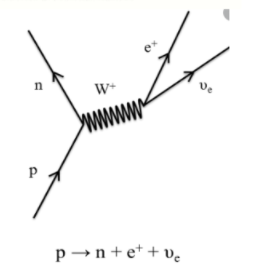
-
Feynman diagram for beta minus decay
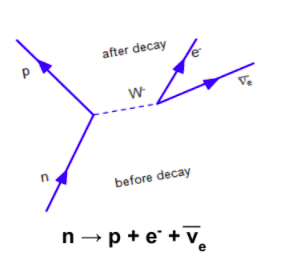
-
Feynman diagram for electron capture
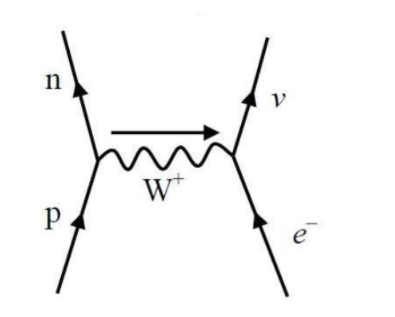
-
Pair productionThe creation of a subatomic particle and antiparticle from a photon with the sfficient rest energy
-
electron capture
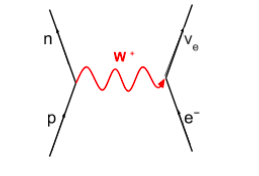 A type of decay
A type of decay -
electron proton collision
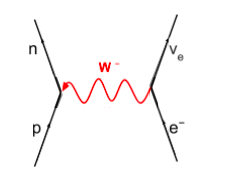
-
Beta plus decay feynman diagram
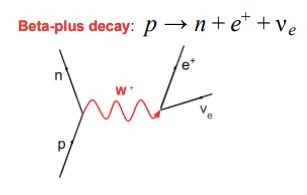
-
Beta minus decay feynman diagram
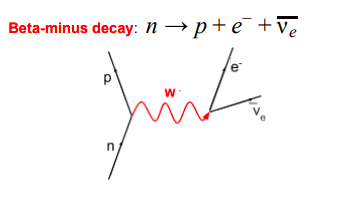
-
What are the main constituents of an atom?Proton Neutron Electron
-
What is meant by specific charge?The charge to mass ration, C/kg
-
What is an isotope?A version of an element with the same number of protons but a different number of neutrons
-
Use of radioactive isotopesCarbon dating - the proportion of carbon-14 in a material can be used to estimate its age
-
How do nuclei with too many nucleons decay?Alpha decay - emit 2p and 2n
-
What is an alpha particle?A particle contains two protons and neutrons
-
What is an antiparticle?For each particle there is an antiparticle with the same rest energy and mass but all other properties are the opposite of its respective particle.
-
Does every particle have an antiparticle?yes
-
Name of the antiparticle of an electron?Positron
-
What is the antiparticle of pion 0pion 0
-
What is the minimu energy of a photon required to make a proton-antiproton pair?2 x proton rest energy
-
The vitual photon is the exchange article of which force?The electromagetic force
-
What does the electromagnetic force act on?It acts on charged objects, for example when a positively charged ball repels another positively charged ball
-
Examples of mesonspion and kaon
-
What particle does a kaon decay into?pion
-
Examples of baryons and its quark structureproton -uud neutron - ddu
-
What is significant about a proton?It is the only stable baryon All baryons will eventually decay into protons
-
What is the straangeness value of a strange quark?-1
-
what are forces between particles caused by?exchange particles
-
what is an antiparticle?Antiparticles have the same rest energy and mass but all its other properties are opposite the particles
-
What can SNF compensate for?But as it doesn't have a charge it can get close to the protons to then compensate for the repulsion of two protons.
-
Why do large nuclei have more neutrons?as the protons repel each other and the more protons there are the greater the electrostatic force of repulsion and so the greater the strong force required to keep it stable but adding more protons will increase the electrostatic force of repulsion and so the number of neutrons become more than that of protonsLarger atoms need more neutrons to compensate more the electrostatic force
-
when is an atom stable?if the forces among the particles that make the nucleus are balanced, an atom is unstable if these forces are unbalanced (the nucleus has an excess of internal energy)
-
total energy equation of a particleTotal energy = m0c^2 + KE
-
electron neutrino mass, rest energy, charge, generation,spin~0,1,1/2
-
electron antineutrino mass, rest energy,charge~0
-
range of gravitational force and what does it act oninfinite, holding matter in planets, stars and galaxies
-
unstable nuclei description, big nuclei vs small nucleiare those which have too many protons or neutrons or both, causing the SNF to not be enough to keep them stable, and so the nuclei will decay in order to become stable.The strong nuclear force and the electrostatic force keep the nuclei of smaller atoms stable but can cause instability in larger atomsThe balance of protons and neutrons needs to be rightLarger atoms need more neutrons to compensate more the electrostatic forceHowever after a certain size no matter what the ratio of protons to neutrons, the nucleus will be too big to be stable
-
power equation (particles)P = E/t & E = hfTherefore P=hf/t
-
why must the minimum frequency be met for pair productionPair production cannot occur if the frequency is below a certain amount as E = hf so the energy of the photon is proportional to its frequency. When pair production occurs the energy is converted to mass according to the equation E = mc2. If the energy/frequency is below the conversion to the mass/rest energy of the particle and antiparticle pair the event will not occur.
-
annhilation diagram
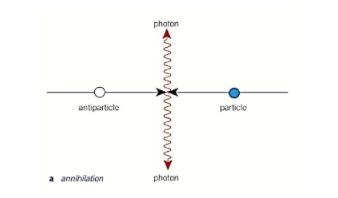
-
pair production diagram
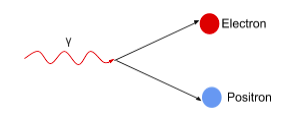
-
muon neutrino Symbol,Relative charge,Relative mass,generation,spinvp,0,~0,2,1/2
-
Strong force Relative strength,EXCHANGE PARTICLE,RANGE (m),ACTS ON1,Gluon(g),3 x 10^-15,Hadrons, holding electrons in atoms;holding atoms together
-
What is a guage boson?A gauge boson is a force carrier, a bosonic particle that carries the forces
-
what do no leptons interact instrong interaction
-
muon Symbol,Relative charge,Relative mass,Rest mass(MeV).generation,spinμ-,-1,-1,106,2,1/2
-
positron generation,charge,spin1,1,1/2
-
electron repusion (EM repulsion) explaination and feynman diagram
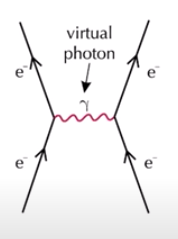 Here two electrons approach each other and they are repelled then they change direction as a virtual photon passes between them (bottom half before interaction, top half after interaction
Here two electrons approach each other and they are repelled then they change direction as a virtual photon passes between them (bottom half before interaction, top half after interaction -
mesons compositionComprised of a quark and an antiquarkMesons are their own particle e.g. K+and K- are anti particles of each other
-
beta plus and beta minus decay equations and feynman diagrams
 p → n + e+ + Ve (+) ___ n → p + e − + Ve (-)
p → n + e+ + Ve (+) ___ n → p + e − + Ve (-) -
electron capture and electron proton collission equations and feynman diagrams
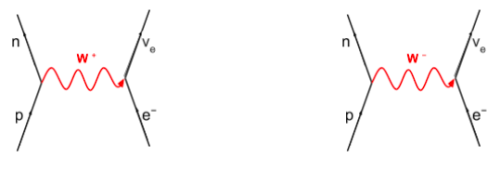 Electron capture: p + e- → n + νe Electron proton collision: p + e- → n + νesecond diagram iswrong it is the wron direction
Electron capture: p + e- → n + νe Electron proton collision: p + e- → n + νesecond diagram iswrong it is the wron direction -
graph of electrostatic force of repulsion vs distance
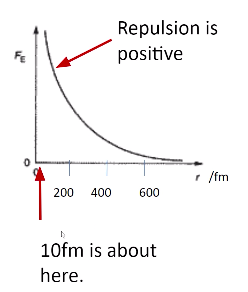 The electrostatic force extends far beyond the nucleus10fm is the diameter of the nucleus
The electrostatic force extends far beyond the nucleus10fm is the diameter of the nucleus -
why does a photon need to pass near an atom for pair production to occurA single photon with sufficient energy and passing near another particle or atom can create a particle-antiparticle pair to conserve charge as photons are neutral (i.e. from energy -> mass)A photon has to be passing near an atom as, when a photon interacts with an orbital electron or a nucleon within the nucleus, the energy of the photon is used to create a particle-antiparticle pair. In order to conserve momentum, the photon needs to interact with interacting particle
-
electron antineutrino generation,charge,spin1,0,1/2
-
Weak interaction Relative strength,EXCHANGE PARTICLE,RANGE (m),ACTS ON~10-5 ,W boson (W+ or W-),10^-17 (due to high mass),All particles, beta decay, decay of unstable hadrons
-
diagram of the classification of particles
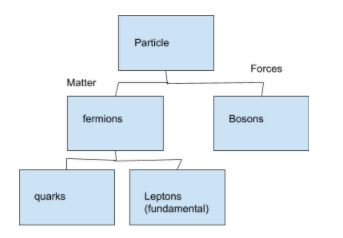
-
minimum energy of a photon for pair production

-
what do only charged leptons interact inonly charged leptons participate in the electromagnetic interaction by emitting or absorbing virtual photons (i.e. not neutrinos) Charged leptons decay into lighter leptons by the weak interaction
-
beta plus decaywhen a proton turns into a neutron and a positron and a neutrinoThis occurs if a nucleus is proton rich (if a nucleus is neutron rich it carries out beta minus decay)
-
Electromagnetic/Electrostatic Relative strength,EXCHANGE PARTICLE,RANGE (m),ACTS ON~10^-2Virtual ,photon (γ),Infinite (virtually no mass),Charged particles, holding electrons in atoms, holding atoms together
-
What is the weak nuclear force responsible for?The weak nuclear force is responsible for beta decay, electron capture and electron-proton collision
-
when light is shone though certain elements what will occurr?Only certain frequencies will be absorbed
-
what is annihilationAnnihilation is where a particle and its corresponding antiparticle collide, as a result their masses are converted into energy (radiation energy) and produce 2 photons in the process
-
what happens during annhilation and propertiesThis energy along with the kinetic energy of the two particles is released in the form of 2 photons moving in opposite directions in order to conserve momentumIt’s always two photons back to back, never just oneAt high energies, massive particles can be created not just photonsIn reality any particle-antiparticle can annihilate not just opposite ones.
-
spins of bosons vs leptonsParticles that have integer spins are known as BosonsParticles that have half integer spins are known as leptons
-
mesons quark grid
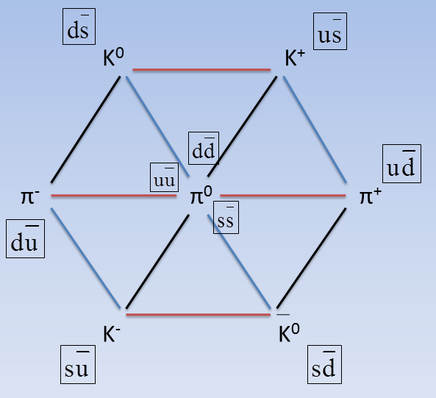
-
proton repulsion explaination and feynman diagram
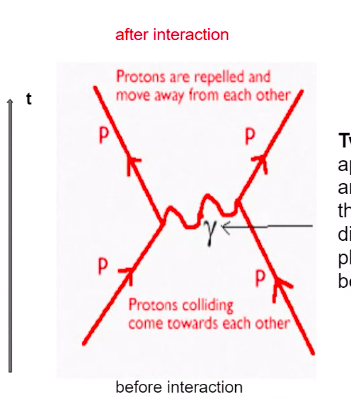 Two protons approach each other and they are repelled, they then change direction as a virtual photon passes between them.
Two protons approach each other and they are repelled, they then change direction as a virtual photon passes between them. -
What happens to the W+ boson in interactionsThe W boson in each beta decay meets a neutrino or antineutrino, changing them into a Beta minus particle (electron) ora beta plus particle (positron)The W- boson decays into a Beta- particles and an antineutrinoThe W+ boson decays into a Beta+ particle and a neutrino
-
Feynman diagram rulesIncoming particles start at the bottom,and travel upwards (the higher you go, the further in time)Baryons (heavy hadrons) and leptons (light particles) stay on their own sidesCharges on both sides must be balancedExchange particles (gauge bosons) are represented by wiggly linesAll other particles are represented by straight lines
-
electron capture vs electron proton collissionThe equations for electron capture and an electron-proton collision are the same however a different exchange particles used, not electrostatic interaction but a weak force interaction
-
neutrino and anti neutrino interactions explainations and feynman diagrams
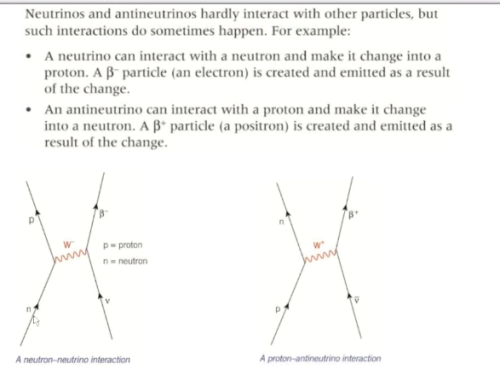
-
quarks properties, spin and chargefundamental propertiesAll have spin of ½ fermions3 generations with increasing massCharge is ⅔ foruptype and -⅓ for down type
-
muon propertiesUnstable : 2.2 micro second half life fundamentalA heavy electron : same charge as the electron207 times heavier at 106 MeV

